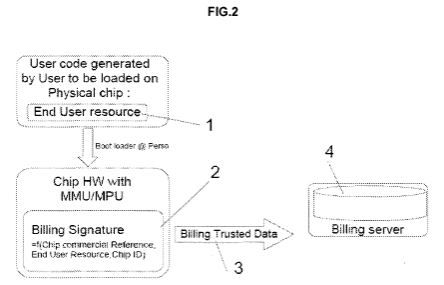This decision relates to a European patent for a method for the selection of an available memory size of a circuit. The patent had been revoked as an outcome of the opposition proceedings. The proprietor appealed, but the Board of Appeal has not overturned the decision of the Opposition Division. Here are the practical takeaways from the decision T 2010/17 (Selection of an available memory size/THALES DIS FRANCE) of 9.6.2021 of Technical Board of Appeal 3.5.07:
Key takeaways
When assessing inventive step using the problem/solution approach, an aim to be achieved in a non-technical field may legitimately be added to the problem as a constraint to be met.
The invention
This European patent relates to a method for the selection of an available memory size of a circuit including at least a processor (for example a CPU, a microprocessor or a processing unit) and a memory.
The patent had been revoked based on the decision from the Opposition Division that claim 1 was not novel over D7.

Fig. 2 of EP2399257
Here is how the invention was defined in claim 1:
· Claim 1 (main request, itemisation in parentheses added by the board)
(1.1)A method for configuring an available memory size of an integrated circuit comprising at least a processor and a total memory,
(1.2) the method comprising a stage for the configuration of an available memory size
(1.3) smaller than or equal to that of the total memory,
(1.4) characterised in that the configuration method is carried out by a circuit user
(1.5) other than the circuit manufacturer, and in that the configuration method includes:
(1.6) – a step of selecting the memory size of the integrated circuit,
(1.7) – a step of registering and locking the selected memory size,
(1.8) where such registration is locked permanently, and
(1.9) – a step of generating a signature representative of the selected memory size by the integrated circuit.
Is it patentable?
During the appeal, the appellant (proprietor) contested that document D7 disclosed features (1.7), (1.8) and (1.9) of claim 1. The Board considers that document D7 discloses features (1.7) and (1.8) but does not explicitly or implicitly disclose feature (1.9) of claim 1:
1.5 The board agrees with the respondent that document D7 discloses features (1.7) and (1.8). These features specify that the selected memory size is registered and locked permanently. The claim wording specifies the method steps on a functional level and does not imply any actions for blocking access to physical memory on a permanent basis (such as using a one-time programming memory, which is disclosed in paragraph [0020] of the patent as an implementation option). The claim features (1.7) and (1.8) specify that only the selected memory size is registered and locked. This is exactly what document D7 discloses in paragraph [0029], where the selected memory size is indicated by the key, which is then applied to permanently enable access to all or some of the partitioned memory depending on the user's selection. In document D7, by use of the received key, the selected memory size is registered permanently. In view of its interpretation of the claimed subject-matter and its analysis of D7, the board is not convinced by the appellant's arguments. Consequently, features (1.7) and (1.8) of claim 1 are disclosed in document D7.
1.6 The board considers that document D7 does not explicitly or implicitly disclose feature (1.9) of claim 1. The term "signature" used in this feature is interpreted as meaning a "security signature" (see paragraph [0021] of the patent) used to calculate a signature for data to be transmitted (see paragraph [0022] of the patent). Hence, the board agrees with the appellant that, at least in the context of the current application, the term "signature" is to be interpreted as being associated with security and may be used for enhancing the security of a message to the server. This interpretation is consistent with the fact that the signature is generated by the integrated circuit itself. Consequently, the board is not convinced by the respondent's arguments that the signature could be interpreted as a clear text signature or as merely providing redundancy for data transmission.
However, the Board considers feature (1.9) cannot be a basis for acknowledging inventive step:
2.1 The skilled person, when starting from document D7, could and would have arrived at feature (1.9) without exercising inventive skill in view of the business requirement to transmit payment data in a secure manner to the manufacturer of the integrated circuit. In this context, the board notes that in accordance with the established case law of the boards, when assessing inventive step using the problem/solution approach, an aim to be achieved in a non-technical field (such as the business need mentioned above) may legitimately be added to the problem as a constraint to be met (see decisions T 641/00, OJ EPO 2003, 352; T 154/04, OJ EPO 2008, 46).
Moreover, it was well known to use digital signatures or the like to enhance the security of messages. The board notes that the contested patent does not disclose any details on how the signature is calculated. It discloses merely which data is used to calculate the signature. In view of this, from the patent specification, it is assumed that it would have been well known to calculate signatures. Since the skilled person would have considered adding a signature to the payment data to be transmitted to the server in D7 as a matter of routine development, it also would have been immediately clear that the signature has to be generated on the side of the sender of the message, i.e. the computer (integrated circuit), and not on the side of the server, as the signature needs to be sent with the payment data. Consequently, feature (1.9) of claim 1 cannot be a basis for acknowledging inventive step.
Therefore, the Board concluded that the subject-matter of claim 1 (main request) does not involve an inventive step (Article 56 EPC). Further, none of the auxiliary requests was admissible. The appeal was dismissed.
More information
You can read the whole decision here: T 2010/17 (Selection of an available memory size/THALES DIS FRANCE) of 9.6.2021 of Technical Board of Appeal 3.5.07.
The content of this article is intended to provide a general guide to the subject matter. Specialist advice should be sought about your specific circumstances.

